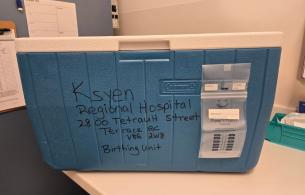Northern Health has a strong vision for creating teams of health care professionals that centre on the person and their family, but making big changes can be challenging. This article is my story of bringing better care to people in Prince Rupert.
I’m an occupational therapist (OT). This means I help people solve problems to make it easier and safer to do everyday things:
- Self-care: getting dressed, eating, or moving around the house
- Being productive: going to work or school, or participating in the community
- Leisure activities: sports, gardening, or social activities[i]
The problem
In 2017, I started working as an OT on the community health care team in Prince Rupert. When I started, there was a large backlog of referrals for me, some from as much as three years ago. It was impossible for me to see everyone quickly enough.
This meant a lot of clients were getting by at home without much support. Some of them suffered falls. Others couldn’t leave their homes because they had pain or problems with mobility. Others weren’t using equipment, like walkers, that could have made them safer.
I wanted to set things up so that people could get therapy earlier, before things got serious. This way, we could head off problems before they happened, and we could help keep people independent and out of the hospital.
But, using the normal channels, I didn’t have time to see all the clients. To solve this problem, I had to think creatively and try new things. I’m passionate about quality improvement, so I enjoyed this process. Here are some of the solutions I came up with.
One-time sessions with clients
The community health care team helped me set up sessions with clients. With their support, I was able to set up one-time face-to-face visits with people who needed help. During the visits, I offered education and gave people advice, such as how to use equipment, and also gave them referrals to community resources and programs.
A couple of months later, I checked in with the clients. They reported that they’d made changes based on my advice, and that they now felt safer at home and more confident. Some of them had started using walkers regularly, some had adapted their home setups, and others had asked for more support from family.
This was a great example of how health care teams can work together to improve their practice and build partnerships with other team members.
Really understanding where people needed help
In collaboration with other OTs across Canada, I created a questionnaire called Occupational Therapy Outcome Indicators to measure people’s overall functioning and quality of life. This made it easier to figure out exactly what areas people needed help with so that we could set goals and make recommendations. It also helped clients understand what I, as an OT, could and couldn’t do.
Working with other health care professionals
I also started three other partnerships with health care professionals with the idea of making services more efficient, enhancing collaboration, and making clients more able to cope on their own:
- Together with a physiotherapist and rehab assistant, I set up a walker clinic.
- I presented as a guest speaker to the Adult Addictions Day Program.
- I presented to a falls prevention group at the Prince Rupert assisted living facility.
These programs let me see more clients at once and provide education and treatment in groups.
It was so beneficial to work with the physiotherapist and rehab assistants on the walker clinic. We completed assessments together and this model offered an opportunity for students that were on clinical placements at the time to learn to work collaboratively with other healthcare providers.
Making changes and trying new things can be difficult, but a preventive approach can help people stay safe, independent, and out of hospital. This also helps reduce the demand on the health care system and, most importantly, gives people improved quality of life and better health.
___
[i] From https://caot.ca/site/rfs/res_for_students?nav=sidebar














Comments